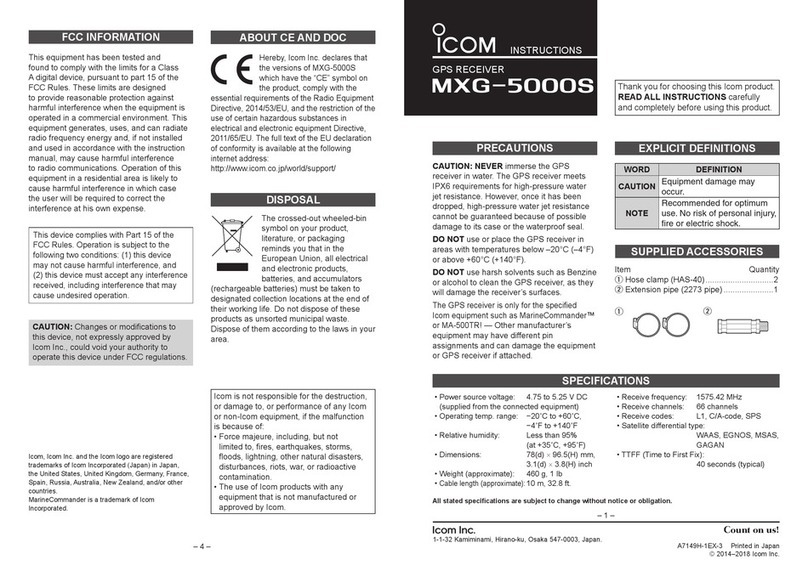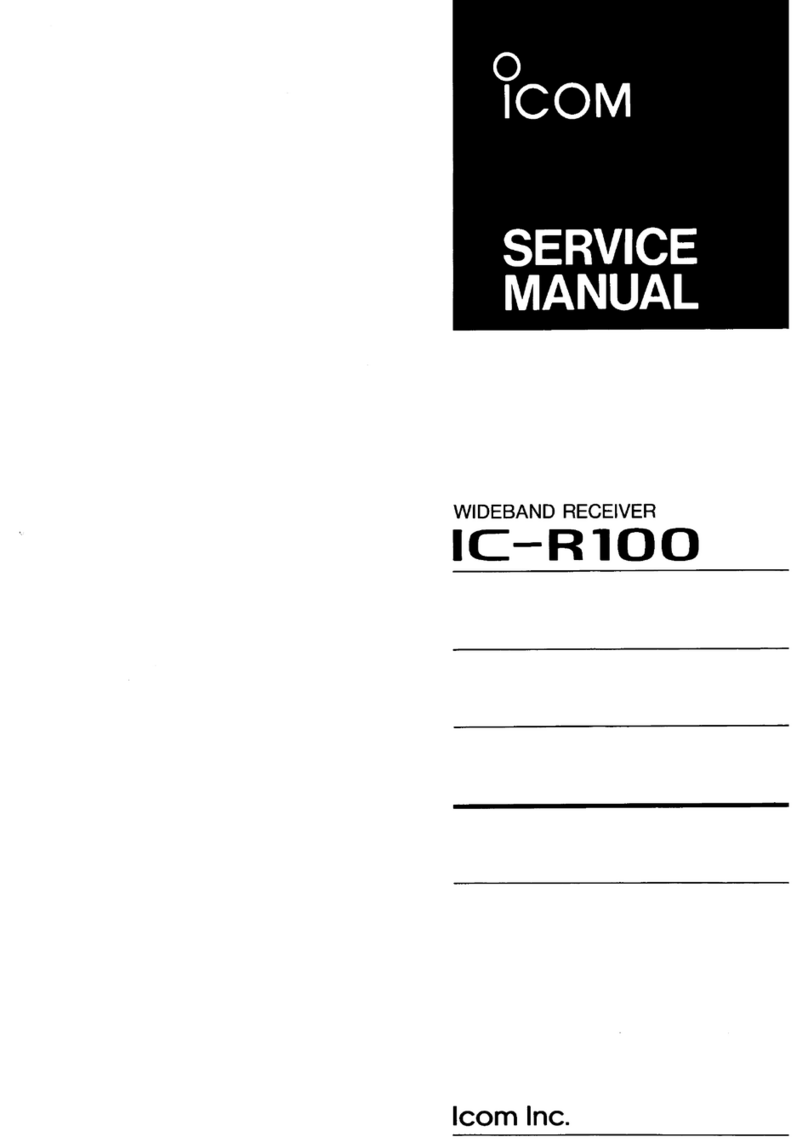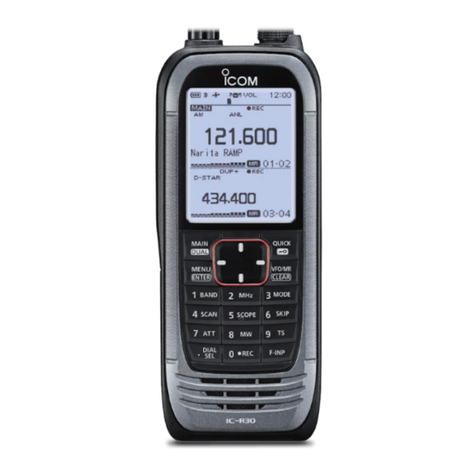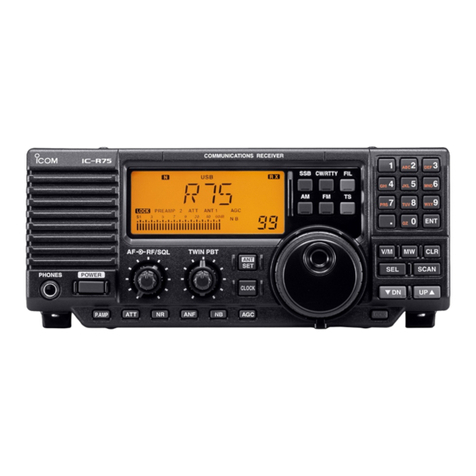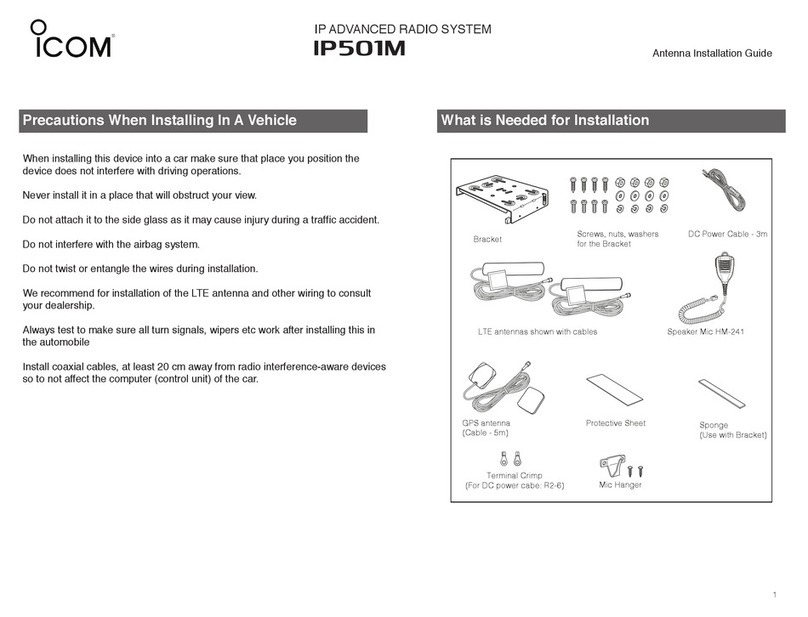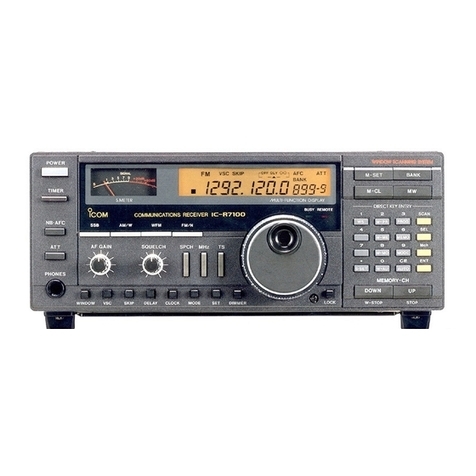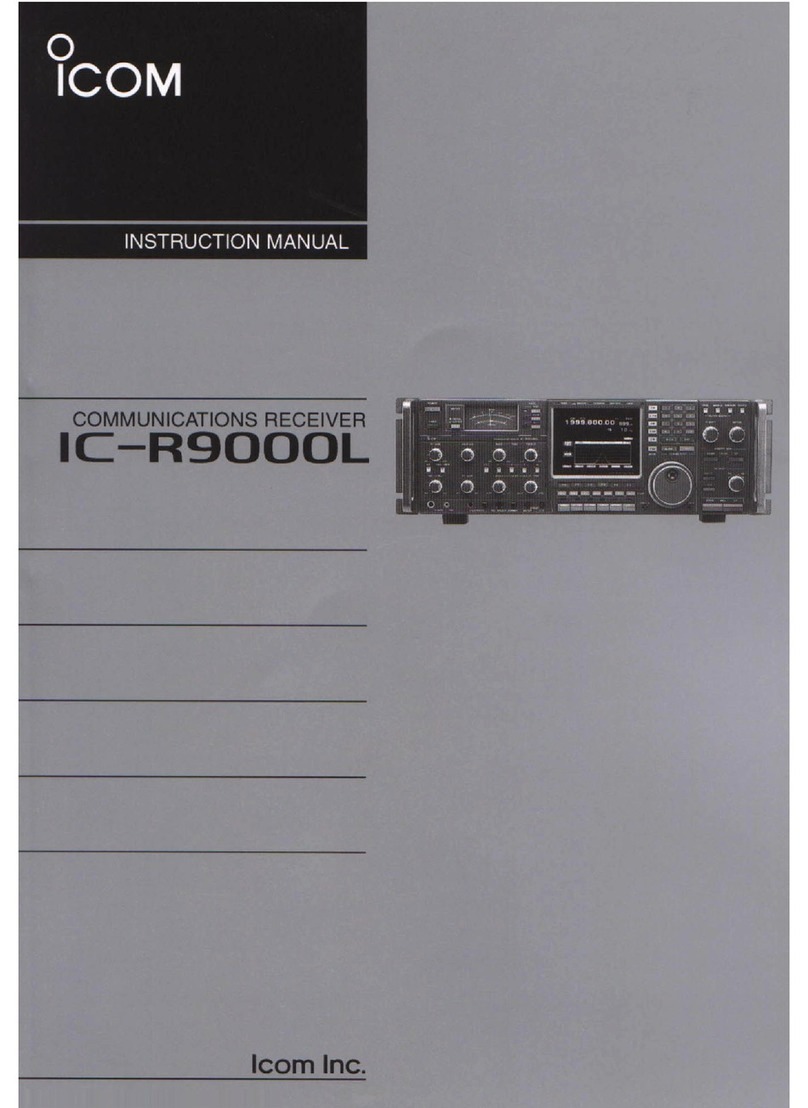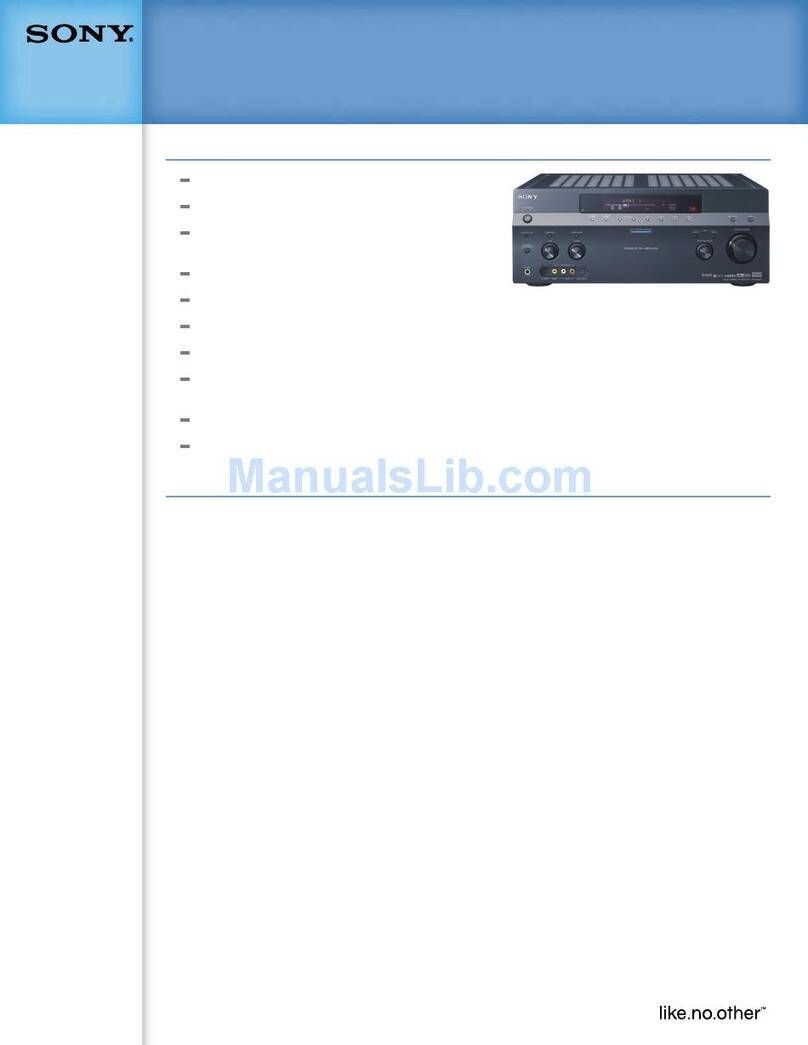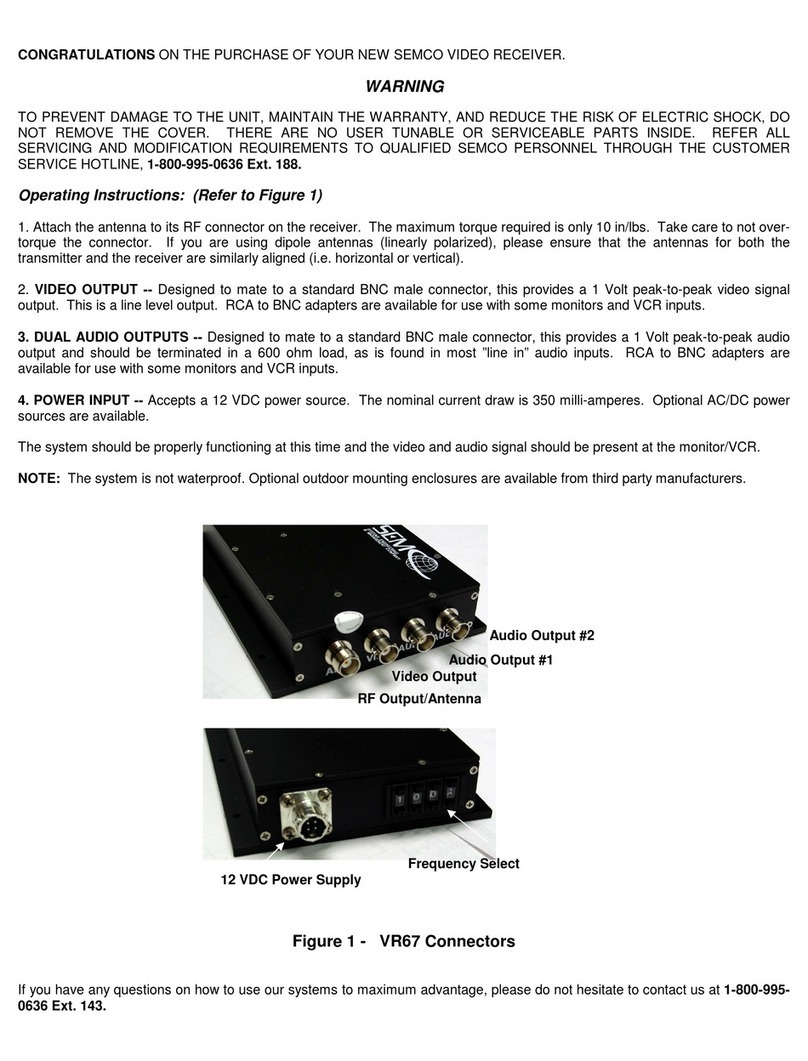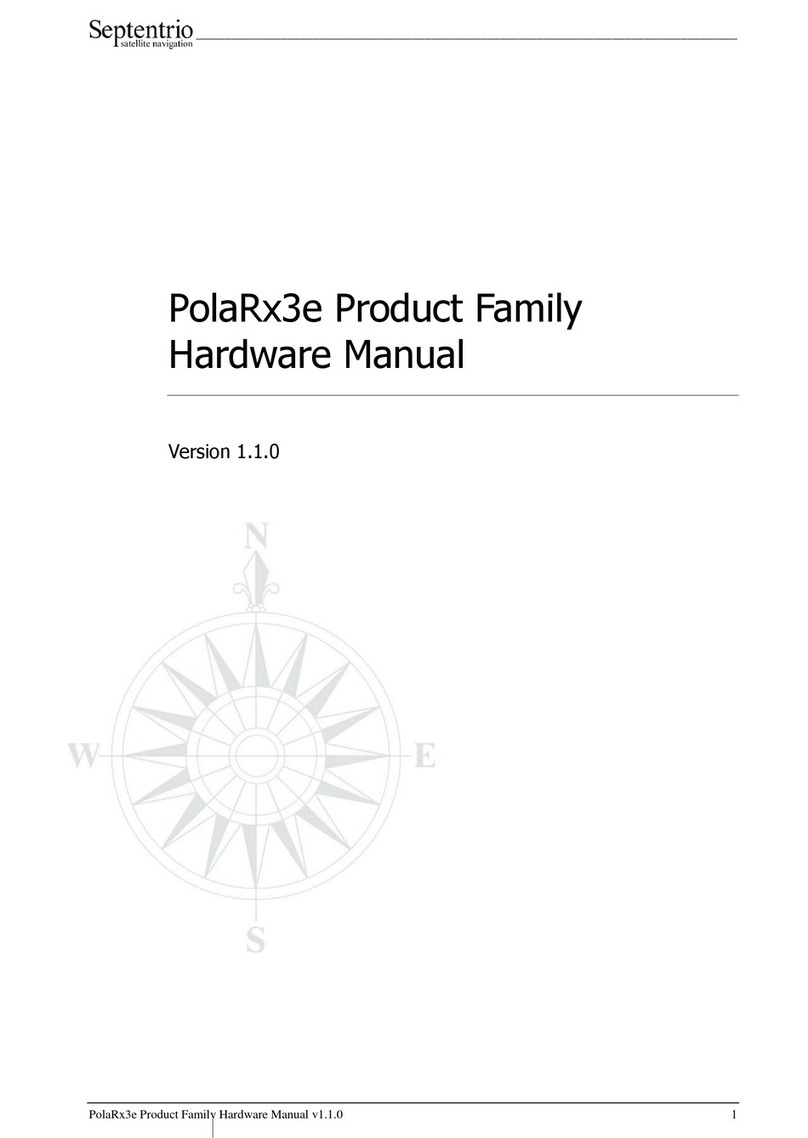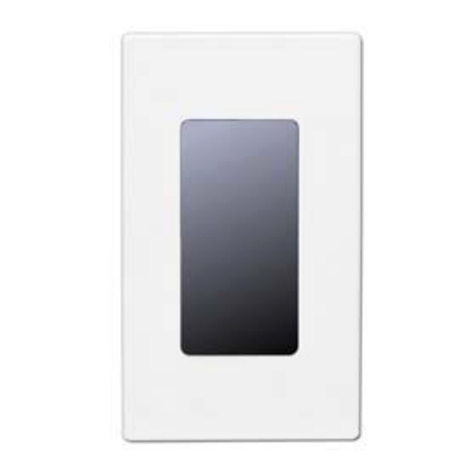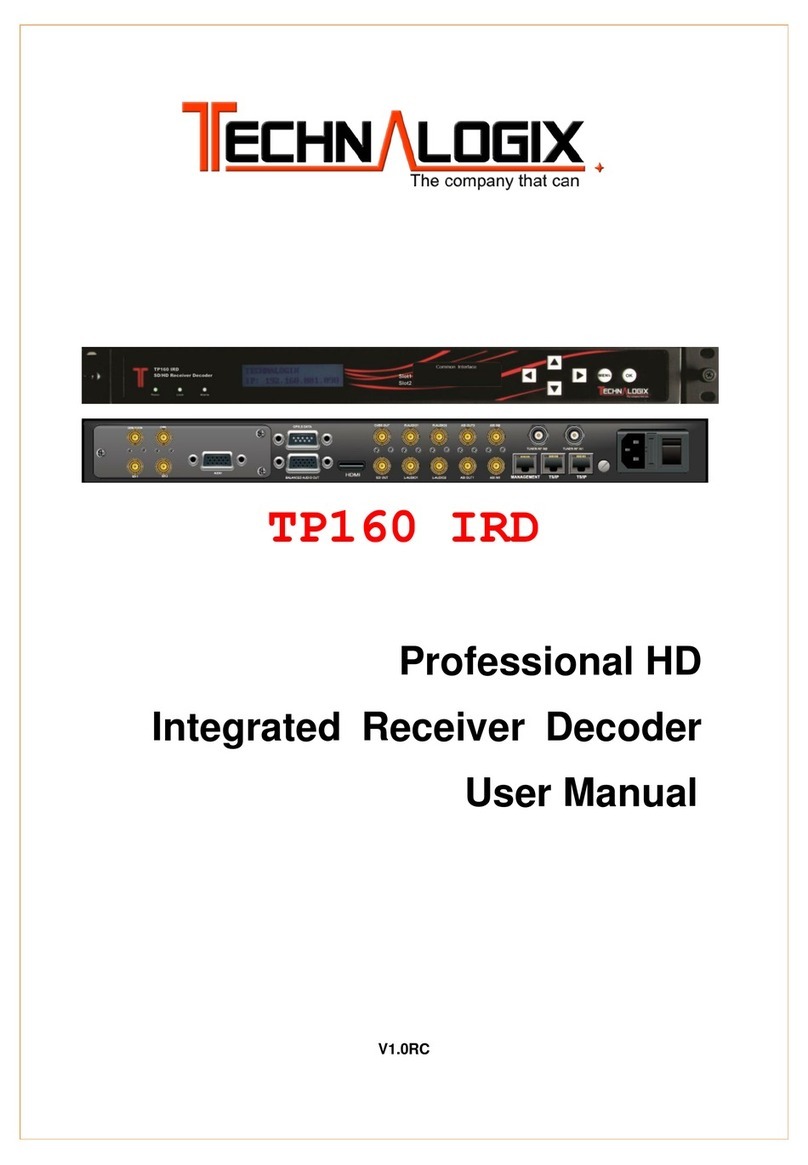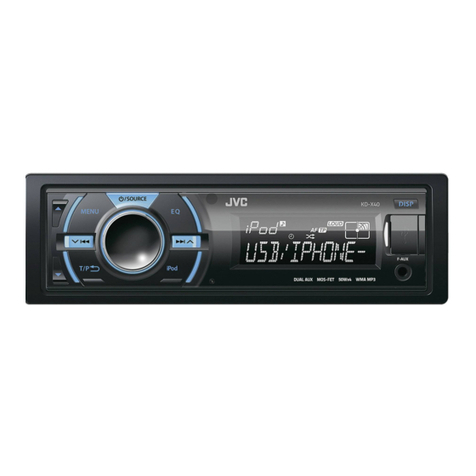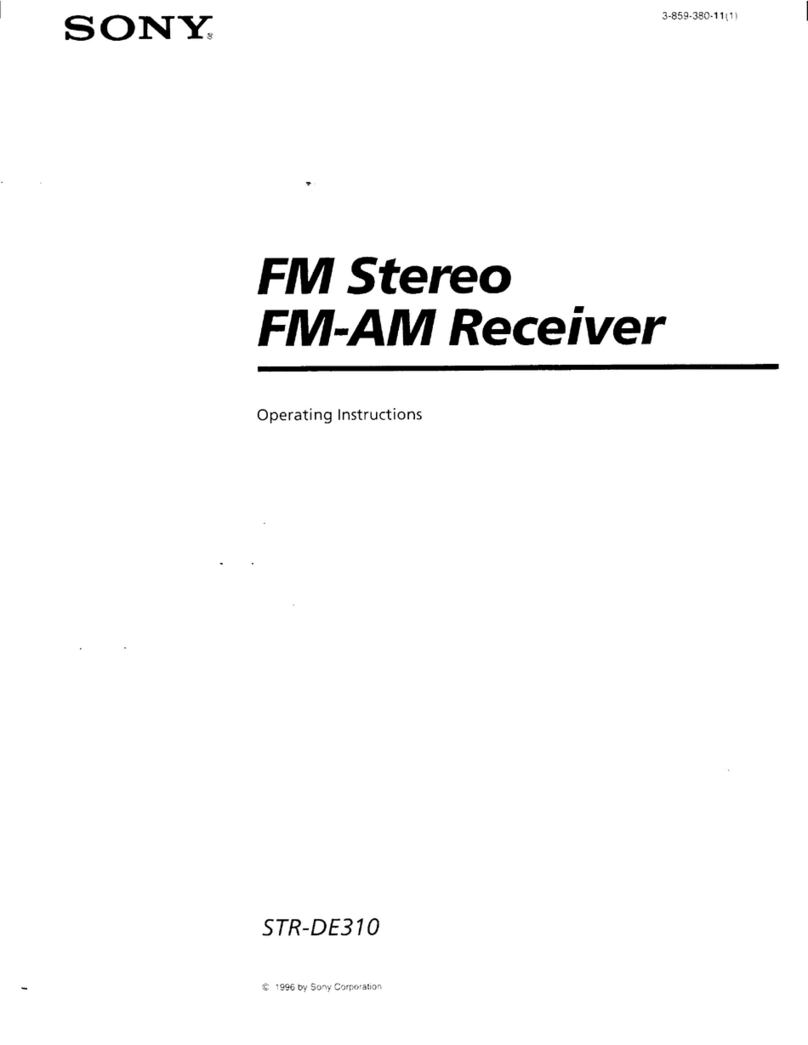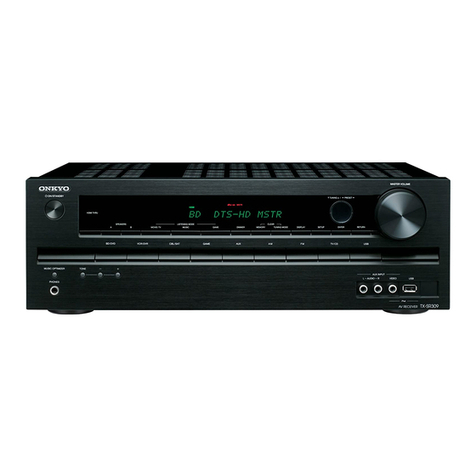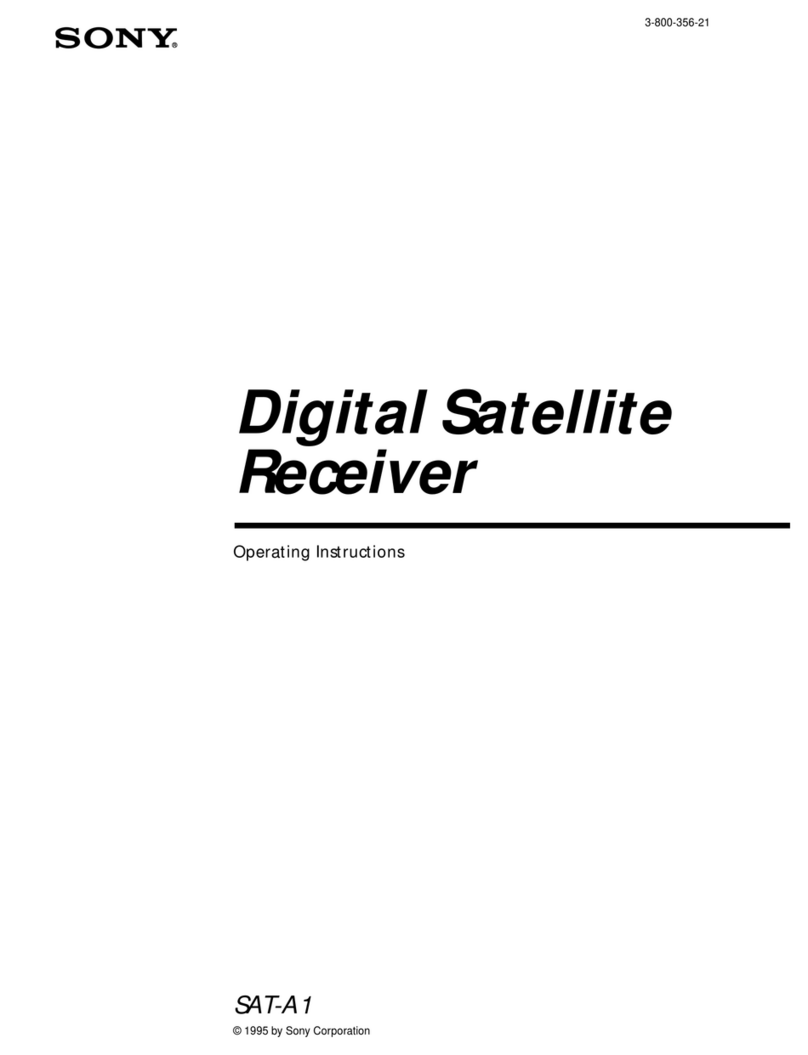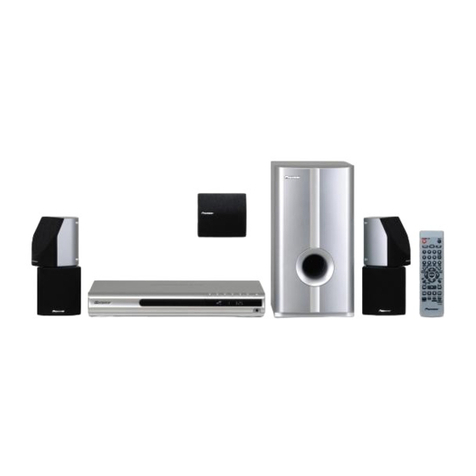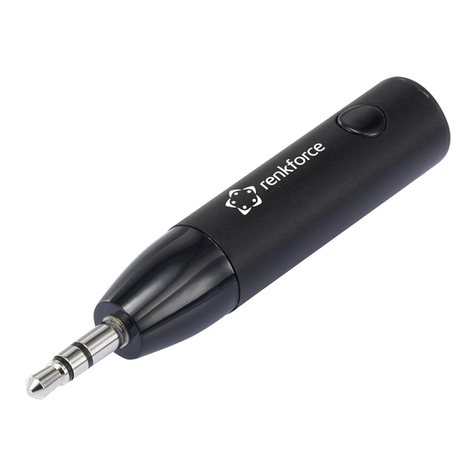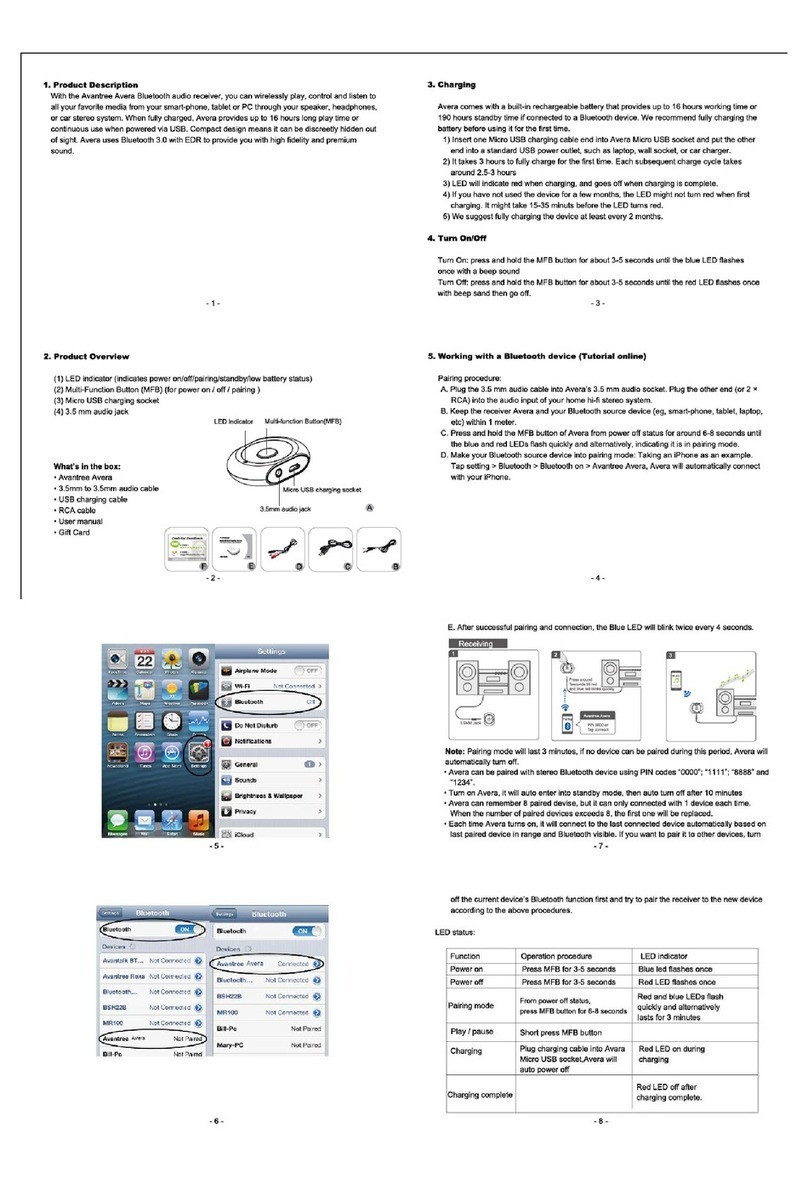Icom IC-R9500 User manual

COMMUNICATIONS RECEIVER
iR9500
Instruction Manual
A-6553H-1EX
Printed in Japan
©2007 Icom Inc.

i
FOREWORD
Thank you for making the IC-R9500 your radio of choice. We hope you
agree with Icom’s philosophy of “technology first.” Many hours of research
and development went into the design of your IC-R9500.
D
FEATURES
❍Ultimate receiver performance: 110 dB wide dynamic range
and third-order intercept (IP3) of +40 dBm (HF bands only)
❍7-inch wide color TFT LCD
❍Built-in Baudot FSK demodulator
❍High resolution spectrum scope— center frequency and fix
frequency modes, plus mini-scope displays
IMPORTANT
READ THIS INSTRUCTION MANUAL CAREFULLY before at-
tempting to operate the receiver.
SAVE THIS INSTRUCTION MANUAL. This manual contains im-
portant safety and operating instructions for the IC-R9500.
EXPLICIT DEFINITIONS
TRADEMARKS
Icom, Icom Inc. and the logo are registered trademarks of Icom
Incorporated (Japan) in the United States, the United Kingdom, Germany,
France, Spain, Russia and/or other countries.
WORD DEFINITION
RRWARNING Personal injury, fire hazard or electric shock may
occur.
CAUTION Equipment damage may occur.
NOTE If disregarded, inconvenience only. No risk of person-
al injury, fire or electric shock.

ii
PRECAUTIONS
RWARNING! NEVER operate the receiver with a
headset or other audio accessories at high volume
levels. Hearing experts advise against continuous high
volume operation. If you experience a ringing in your
ears, reduce the volume or discontinue use.
RCAUTION! NEVER change the internal set-
tings of the receiver. This may reduce receiver perfor-
mance and/or damage to the receiver.
The receiver warranty does not cover any problems
caused by unauthorized internal adjustment.
RCAUTION! The receiver weighs approx. 20 kg
(44 lb). Always have two people available to carry, lift
or turn over the receiver.
RCAUTION! The line-voltage receptacle must be
near the receiver and must be easily accessible. Avoid
extension cords.
RACHTUNG! Die Steckdose muß nabe bei
diesem Gerät angebracht und zugänglich sein.
RNEVER let metal, wire or other objects protrude
into the receiver or into connectors on the rear panel.
This may result in an electric shock.
RNEVER block any cooling vents on the top, rear
or bottom of the receiver.
RNEVER expose the receiver to rain, snow or any
liquids.
RNEVER install the receiver in a place without ad-
equate ventilation. Heat dissipation may be reduced,
and the receiver may be damaged.
RNEVER operate or touch the receiver with wet
hands. This may result in an electric shock or damage
to the receiver.
DO NOT
use chemical agents such as benzine or al-
cohol when cleaning the IC-R9500, as they can dam-
age the receiver’s surfaces.
AVOID using or storing the receiver in areas with tem-
peratures below ±0°C (+32°F) or above +50°C
(+122°F).
AVOID placing the receiver in excessively dusty envi-
ronments or in direct sunlight.
AVOID placing the receiver against walls or putting
anything on top of the receiver. This may overheat the
receiver.
Always place unit in a secure place to avoid inadver-
tent use by children.
The LCD display may have cosmetic imperfections that
appear as small dark or light spots. This is not a mal-
function or defect, but a normal characteristic of LCD
displays.
During maritime mobile operation, keep the receiver as
far away as possible from the magnetic navigation
compass to prevent erroneous indications.
Turn [I/O] switch (on the rear panel) OFF and/or dis-
connect the AC power cable from the AC outlet when
you will not use the receiver for a long period of time.
For U.S.A. only
CAUTION: Changes or modifications to this device,
not expressly approved by Icom Inc., could void your
authority to operate this device under FCC regulations.
ABOUT APCO PROJECT 25
This device made under license under one or more of
the following US patents: #4,590,473, #4,636,791,
#5,148,482, #5,185,796, #5,271,017, #5,377,229.
The IMBE™ voice coding technology embodied in this
product is protected by intellectual property rights
including patent rights, copyrights and trade secrets of
Digital Voice Systems, Inc. This voice coding
Technology is licensed solely for use within this com-
munications equipment. The user of this technology is
explicitly prohibited from attempting to decompile,
reverse engineer, or disassemble the object code, or
in any other way convert the object code into a
human-readable form. U.S. Pat. nos. #5,870,405,
#5,826,222, #5,754,974, #5,701,390, #5,715,365,
#5,649,050, #5,630,011, #5,581,656, #5,517,511,
#5,491,772, #5,247,579, #5,226,084, #5,195,166.
P25 digital mode is available when the optional
UT-122 DIGITAL UNIT is installed.

qAC power cable* ………………………………… 1
wCarrying handles ……………………………… 1 set
eSpare fuse (FGB 1 A) …………………………… 1
rSpare fuse
FGB 4 A (100 V/120 V versions) ………………… 1
0234002MXP (230 V/240 V versions)
…………… 1
tRCA plugs ………………………………………… 4
yDC power plug …………………………………… 1
u2-conductor 1⁄8″plugs …………………………… 7
i3-conductor 1⁄8″plugs …………………………… 1
o8 pin ACC plugs …………………………………… 2
!0 Screws for side plate†…………………………… 4
!1 Hiding screws for screw hole†…………………… 2
*May differ from that shown according to version
†These screw are used when removing rack mounting han-
dles
iii
SUPPLIED ACCESSORIES
q
o
!0
!1
tyu i
e
wr
(FH M4×16 mm)
(FH M4×12 mm)
(PH M4×8 mm) PH: Pan head
FH: Flat head

iv
Section 1 PANEL DESCRIPTION
■Front panel ……………………………………………………………… 1-2
■Rear panel ……………………………………………………………… 1-8
■LCD display …………………………………………………………… 1-10
■Screen menu arrangement …………………………………………… 1-12
Section 2 INSTALLATION AND CONNECTIONS
■Unpacking ……………………………………………………………… 2-2
■Selecting a location …………………………………………………… 2-2
■Grounding ……………………………………………………………… 2-2
■Antenna connection …………………………………………………… 2-3
■TV jumper cable connection …………………………………………… 2-4
■Carrying handle attachment …………………………………………… 2-4
■Rack mounting handle detachment …………………………………… 2-4
■Required connections ………………………………………………… 2-5
DRear panel …………………………………………………………… 2-5
■Advanced connections ………………………………………………… 2-6
DFront panel …………………………………………………………… 2-6
DRear panel—1 ……………………………………………………… 2-6
DRear panel—2 ……………………………………………………… 2-7
■Tape recorder connections …………………………………………… 2-8
DRecording from the front panel or rear panel …………………… 2-8
DSeparately recording audio and frequency ……………………… 2-9
■Monitor display connection …………………………………………… 2-10
■Transceive function …………………………………………………… 2-10
■FSK and AFSK (SSTV) connections ………………………………… 2-11
■Accessory connector information …………………………………… 2-12
Section 3 BASIC OPERATIONS
■When first applying power (CPU resetting) ………………………… 3-2
■Initial settings …………………………………………………………… 3-2
■Selecting VFO mode …………………………………………………… 3-3
■Selecting memory mode ……………………………………………… 3-3
■Frequency setting ……………………………………………………… 3-4
DDirect frequency entry with the keypad …………………………… 3-4
DTuning with the main dial …………………………………………… 3-5
DSelecting a tuning step ……………………………………………… 3-5
DAuto tuning step function …………………………………………… 3-6
D1⁄4tuning step function ……………………………………………… 3-6
■Operating mode selection ……………………………………………… 3-7
■Volume setting ………………………………………………………… 3-8
■RF gain adjustment …………………………………………………… 3-8
■Squelch level adjustment ……………………………………………… 3-8
■Audio tone adjustment ………………………………………………… 3-9
DTreble level adjustment ……………………………………………… 3-9
DBass level adjustment ……………………………………………… 3-9
■Meter indication selection …………………………………………… 3-10
DMeter type selection ……………………………………………… 3-10
Section 4 RECEIVE MODES
■Operating FM …………………………………………………………… 4-2
DConvenient functions for FM …………………………………………4-2
■Duplex operation ……………………………………………………… 4-3
DOffset frequency setting ………………………………………………4-3
TABLE OF CONTENTS

■Tone/DTCS squelch operation ………………………………………… 4-4
■Operating WFM ………………………………………………………… 4-5
DConvenient functions for WFM ………………………………………4-5
■TV channel operation ………………………………………………… 4-6
DConvenient functions for TV operation ……………………………4-6
■Operating AM …………………………………………………………… 4-7
DConvenient functions for AM …………………………………………4-7
■Operating SSB ………………………………………………………… 4-8
DConvenient functions for SSB ………………………………………4-8
■Operating CW …………………………………………………………… 4-9
DConvenient functions for CW ………………………………………4-9
DAPF (Audio Peak Filter) operation …………………………………4-10
DAbout CW reverse mode ……………………………………………4-10
DAbout CW pitch control ……………………………………………4-10
■Operating FSK ………………………………………………………… 4-11
DConvenient functions for FSK ………………………………………4-12
DAbout FSK reverse mode …………………………………………4-12
DTwin peak filter ………………………………………………………4-12
DFunctions for the FSK decoder indication …………………………4-13
DSetting the decoder threshold level ………………………………4-13
DFSK decode set mode ………………………………………………4-14
DTime stamp function …………………………………………………4-15
DSetting FSK tone frequency ………………………………………4-16
DSetting FSK Baud rate ………………………………………………4-16
DData saving …………………………………………………………4-17
■Operating P25 (Requires optional UT-122) ………………………… 4-18
DConvenient functions for P25 ………………………………………4-18
■Digital squelch operation ……………………………………………… 4-19
Section 5 RECEIVE FUNCTIONS
■Spectrum scope screen ……………………………………………… 5-2
DCenter mode ………………………………………………………… 5-2
DFix mode ……………………………………………………………… 5-3
DPeak marker function ……………………………………………… 5-4
DWide band-pass filter selection……………………………………… 5-5
DWide band scope function …………………………………………… 5-5
DMini scope screen indication ……………………………………… 5-6
DScope set mode ……………………………………………………… 5-6
■Preamplifier ……………………………………………………………… 5-9
■Attenuator ……………………………………………………………… 5-9
■AGC function …………………………………………………………… 5-10
DSelecting the preset value …………………………………………5-10
DAdjusting the AGC time constant …………………………………5-10
DSetting the AGC time constant preset value ……………………5-10
■Twin PBT operation …………………………………………………… 5-11
■IF filter selection ……………………………………………………… 5-12
DIF filter selection …………………………………………………… 5-12
DFilter passband width setting ……………………………………… 5-12
DRoofing filter selection ……………………………………………… 5-13
DDSP filter shape …………………………………………………… 5-13
DFilter shape set mode ……………………………………………… 5-13
■Noise blanker ………………………………………………………… 5-15
DNB set mode ………………………………………………………… 5-15
v
TABLE OF CONTENTS

vi
■Noise reduction ………………………………………………………… 5-16
■Notch function ………………………………………………………… 5-16
■Autotune function ……………………………………………………… 5-17
■AFC function …………………………………………………………… 5-17
Section 6 VOICE RECORDER FUNCTIONS
■About digital voice recorder …………………………………………… 6-2
■Recording a received audio …………………………………………… 6-3
DRegular recording …………………………………………………… 6-3
■Playing the recorded audio …………………………………………… 6-3
DRegular playing ……………………………………………………… 6-3
■Erasing the recorded contents ………………………………………… 6-4
■Selecting the CF memory card or USB-Memory …………………… 6-4
■Short recording ………………………………………………………… 6-5
DRecording …………………………………………………………… 6-5
DPlaying back ………………………………………………………… 6-5
■Voice set mode ………………………………………………………… 6-6
Section 7 MEMORY OPERATION
■Memory channels ……………………………………………………… 7-2
■Memory channel selection …………………………………………… 7-3
DUsing the [M-CH]/[BANK] selectors ……………………………… 7-3
DUsing the keypad …………………………………………………… 7-3
■Memory channel programming ……………………………………… 7-4
DProgramming in VFO mode ………………………………………… 7-4
DProgramming in memory mode …………………………………… 7-4
■Frequency transferring ………………………………………………… 7-5
DTransferring in VFO mode ………………………………………… 7-5
DTransferring in memory mode ……………………………………… 7-5
■Memory names ………………………………………………………… 7-6
DEditing (programming) memory names …………………………… 7-6
■Memory clearing ………………………………………………………… 7-6
■Memory list screen ……………………………………………………… 7-7
DSelecting a memory channel using the memory list screen …… 7-7
DConfirming programmed memory channels ……………………… 7-7
DMemory bank set …………………………………………………… 7-8
Section 8 SCANS
■Scan types ……………………………………………………………… 8-2
■Preparation ……………………………………………………………… 8-3
■Voice squelch control function ………………………………………… 8-3
■Scan set mode ………………………………………………………… 8-4
■Priority scan ……………………………………………………………… 8-5
DSetting ………………………………………………………………… 8-5
DPriority scan operation ……………………………………………… 8-5
■Programmed scan ……………………………………………………… 8-6
DSetting ………………………………………………………………… 8-6
DProgram scan operation …………………………………………… 8-7
■∂F scan ………………………………………………………………… 8-8
DSetting ………………………………………………………………… 8-8
D∂F scan operation …………………………………………………… 8-8
■Fine programmed scan/fine ∂F scan operation……………………… 8-9
■Auto memory write scan operation…………………………………… 8-10
TABLE OF CONTENTS

■Memory scan …………………………………………………………… 8-11
DSetting ……………………………………………………………… 8-11
DMemory scan operation …………………………………………… 8-11
DProgramming the select memory scan setting ………………… 8-12
DSelect memory scan operation …………………………………… 8-13
DMode select memory scan operation …………………………… 8-14
■Skip scan ……………………………………………………………… 8-15
DSpecifying skip channels ………………………………………… 8-15
DProgramming skip frequencies (for programming scan) ……… 8-15
DSkip scan setting …………………………………………………… 8-15
■Tone scan ……………………………………………………………… 8-16
■Scan resume condition………………………………………………… 8-17
■Scan speed …………………………………………………………… 8-18
■Scan delay ……………………………………………………………… 8-18
Section 9 OTHER FUNCTIONS
■Voice synthesizer operation …………………………………………… 9-2
■Lock function …………………………………………………………… 9-2
DDial lock function ……………………………………………………… 9-2
DPanel lock function …………………………………………………… 9-2
■Dial click function ……………………………………………………… 9-3
■Antenna selection ……………………………………………………… 9-3
Section 10 CLOCK AND TIMERS
■Time set mode ………………………………………………………… 10-2
■Daily timer setting …………………………………………………… 10-3
■Setting sleep timer …………………………………………………… 10-4
■Timer operation ………………………………………………………… 10-4
Section 11 SET MODE
■Set mode description ………………………………………………… 11-2
DSet mode operation ………………………………………………… 11-2
DScreen arrangement ……………………………………………… 11-3
■Level set mode ………………………………………………………… 11-4
■ACC set mode ………………………………………………………… 11-7
■Display set mode ……………………………………………………… 11-8
■Others set mode ……………………………………………………… 11-10
■CF card/USB-Memory set menu …………………………………… 11-16
DCF/USB-Memory set screen arrangement …………………… 11-16
DLoad option set mode …………………………………………… 11-17
■File saving …………………………………………………………… 11-18
■File loading …………………………………………………………… 11-19
■Changing the file name ……………………………………………… 11-20
■File copying …………………………………………………………… 11-21
■Deleting a file ………………………………………………………… 11-22
■Unmount an USB-Memory ………………………………………… 11-22
■Formatting the CF card or USB-Memory ………………………… 11-23
■Display set (Video) mode …………………………………………… 11-24
■LCD set mode ………………………………………………………… 11-26
Section 12 MAINTENANCE
■Troubleshooting ……………………………………………………… 12-2
DReceiver power …………………………………………………… 12-2
DReceiving …………………………………………………………… 12-2
vii
TABLE OF CONTENTS

viii
DScanning …………………………………………………………… 12-3
DDisplay ……………………………………………………………… 12-3
DVoice recorder ……………………………………………………… 12-3
DFormat memory media …………………………………………… 12-3
■Screen type selection ………………………………………………… 12-4
■Main dial brake adjustment ………………………………………… 12-4
■Frequency calibration (approximate) ……………………………… 12-5
■Opening the receiver’s case ………………………………………… 12-6
■Opening the shield case ……………………………………………… 12-6
■UT-122 installation …………………………………………………… 12-7
■Clock backup battery replacement ………………………………… 12-7
■Fuse replacement …………………………………………………… 12-8
DAC power input fuse ……………………………………………… 12-8
DDC output fuse ……………………………………………………… 12-8
■Resetting the CPU …………………………………………………… 12-9
■Screen Saver Function ……………………………………………… 12-9
Section 13 CONTROL COMMAND
■Remote interface (CI-V) information ………………………………… 13-2
DCI-V connection example ………………………………………… 13-2
DData format ………………………………………………………… 13-2
DCommand table …………………………………………………… 13-3
DTo send/read memory contents ………………………………… 13-10
DCodes for memory name, bank name, opening message,
and clock 2 name contents ……………………………………… 13-10
DOffset frequency setting ………………………………………… 13-10
DTone squelch frequency setting ………………………………… 13-10
DDTCS squelch code setting ……………………………………… 13-10
DNAC squelch code setting ……………………………………… 13-11
DSelective squelch code settings ………………………………… 13-11
DColor setting ……………………………………………………… 13-11
DData mode with filter width setting ……………………………… 13-11
Section 14 SPECIFICATIONS AND OPTIONS
■Specifications ………………………………………………………… 14-2
DGeneral ……………………………………………………………… 14-2
DReceiver …………………………………………………………… 14-3
■Options ………………………………………………………………… 14-4
Section 15 UPDATING THE FIRMWARE
■General ………………………………………………………………… 15-2
■Caution ………………………………………………………………… 15-2
■Preparation …………………………………………………………… 15-3
DFirmware and firm utility …………………………………………… 15-3
DFile downloading …………………………………………………… 15-3
■Firmware update— CF memory card ……………………………… 15-4
■Firmware update— PC ……………………………………………… 15-6
DConnections ………………………………………………………… 15-6
DIP address setting ………………………………………………… 15-7
DUpdating from the PC ……………………………………………… 15-8
TABLE OF CONTENTS


1-1
PANEL DESCRIPTION Section 1
■Front panel ……………………………………………………………… 1-2
■Rear panel ……………………………………………………………… 1-8
■LCD display …………………………………………………………… 1-10
■Screen menu arrangement …………………………………………… 1-12

1-2
■Front panel
qPOWER SWITCH [POWER] (p. 3-2)
➥Push to turn the receiver power ON.
•The [POWER] indicator above this switch lights green
when powered ON.
➥Push for 1 sec. to turn the receiver power OFF.
•The [POWER] indicator lights orange when the re-
ceiver is OFF when the internal power supply is
switched ON.
wREMOTE CONTROL SWITCH [LOCAL]
Push to cancel remote control operation from a PC
via a CI-V data.
•The [REMOTE] indicator lights yellow while in remote
control operation.
•When the [REMOTE] indicator lights yellow, all dials,
keys or switches other than this switch are disabled.
ePANEL LOCK SWITCH [PANEL LOCK] (p. 9-2)
Push to turn the panel lock function ON or OFF. The
panel lock function locks all dials, keys and switches
other than [POWER] and [PANEL LOCK].
•The [PANEL LOCK] indicator above this switch lights
yellow when the timer is in use.
•The dial lock function is also available.
rTIMER SWITCH [TIMER] (p. 10-3)
➥Turns the sleep or daily timer function ON or
OFF.
•The [TIMER] indicator above this switch lights green
when the timer is in use.
➥Enters timer set mode when pushed and held for
1sec.
tRECORDER REMOTE JACK [REC REMOTE]
Controls the operation of a tape recorder for record-
ing. Connects to the REMOTE jack on a tape
recorder.
yRECORDER JACK [REC OUT]
Outputs an audio signal. Connect to the AUX or
LINE IN jack on a tape recorder.
uHEADPHONE JACK [PHONES]
Accepts standard 3.5 (d) mm (1⁄8) stereo head-
phones.
•Output power: 40 mW with an 8 Ωload.
•When headphones are connected, the internal speaker
or connected external speaker does not function.
iSQUELCH CONTROL [SQUELCH] (p. 3-8)
Adjusts the squelch threshold level. The squelch
disables output from the speaker (closed condition)
when no signal is received.
•The squelch control is particularly effective for FM or
AM. It is also available for other modes.
•11 to 12 o’clock position is recommended for any set-
ting of the [SQL] control.
Deep
Deep
S-meter
squelch
Noise squelch
Squelch
is open.
Squelch
threshold
Shallow Shallow
Turn the internal power supply ON before turning the
unit ON from the front panel. The internal power sup-
ply switch is located on the rear panel. (p. 3-2)
1PANEL DESCRIPTION
i!0
q
w
e
r
t
y
u
o!1 !2
!3 !4 !5 !8
!6 !7

1-3
oPASSBAND TUNING CONTROLS [TWIN PBT]
(p. 5-11)
Adjusts the IF filter “passband width” via the DSP.
•Passband width and shift frequency are shown on the
multifunction display.
•Push and hold [PBT CLEAR] for 1 sec. to clear the PBT
settings.
•Variable range is set to half of the IF filter passband
width. 25 Hz steps and 50 Hz steps are available in
SSB, CW and FSK modes.
✔
What is the PBT control?
The PBT function electronically modifies the IF passband
width to reject interference. This receiver uses the DSP cir-
cuit for the PBT function.
!0 PBT CLEAR SWITCH [PBT CLEAR] (p. 5-11)
Push and hold for 1 sec. to clear the PBT settings.
•The [PBT CLEAR] indicator above this switch lights
when PBT is in use.
!1 AGC CONTROL [AGC] (p. 5-10)
Adjusts the continuously-variable AGC circuit time
constant.
•To use [AGC] control, push the appropriate band’s
[AGC VR/OFF] ([AGC VR] indicator lights green).
!2 AGC SWITCH [AGC VR/OFF] (p. 5-10)
➥Push to toggle [AGC] control usage ON or OFF.
•Use [AGC] control to set the AGC time constant when
switched ON.
•The [AGC VR] indicator above this switch lights
green when the control is ON.
➥Turns the AGC function OFF when pushed and
held for 1 sec.
!3 AUTO NOTCH SWITCH [ANF] (p. 5-16)
➥Turns the auto notch function ON or OFF when
pushed in SSB, AM, FM and WFM mode.
•“ ” appears when auto notch is in use.
!4 MANUAL NOTCH SWITCHES
[NOTCH1]/[NOTCH2] (p. 5-16)
➥Turns the manual notch function ON or OFF
when pushed in SSB, CW, AM and FSK mode.
•“ ” or “ ” appear when manual notch is in use.
➥Switches the manual notch characteristics be-
tween wide, middle and narrow when pushed
and held for 1 sec.
✔
What is the notch function?
The notch function eliminates unwanted CW or AM carrier
tones while preserving the desired voice signal. The DSP cir-
cuit automatically adjusts the notch frequency to effectively
eliminate unwanted tones.
!5 MANUAL NOTCH FILTER CONTROLS
[NOTCH1]/[NOTCH2] (p. 5-16)
Varies the “notch” frequency of the manual notch fil-
ter to reject an interfering signal while the manual
notch function is ON.
•Notch filter center frequency:
SSB : –1060 Hz to 4040 Hz
CW : CW pitch freq. + 2540 Hz to CW pitch freq.
–2540 Hz
AM : –5100 Hz to 5100 Hz
!6 AUDIO PEAK FILTER/TWIN PEAK FILTER
SWITCH [APF/TPF]
➥Push to turn the audio peak filter ON or OFF dur-
ing CW mode operation. (p. 4-10)
➥Push to turn the twin peak filter ON or OFF dur-
ing FSK mode operation. (p. 4-12)
•“ ” appears when audio peak filter is in use.
•“ ” appears when twin peak filter is in use.
➥During CW mode operation, push and hold for
1sec. to select the APF passband width from 80,
160 and 320 Hz. (p. 4-10)
!7 NOISE BLANKER SWITCH [NB] (p. 5-15)
➥Selects from noise blanker 1, 2, or OFF when
pushed. The noise blanker reduces pulse-type
noise such as that generated by automobile igni-
tion systems. This function cannot be used for
FM/WFM, P25 modes or non-pulse-type noise.
•The [NB] indicator above this switch lights green and
“NB1” or “NB2” appears on the display when the
function is activated.
➥Enters blank-width set mode when pushed and
held for 1 sec.
!8 NOISE REDUCTION SWITCH [NR] (p. 5-16)
Push to switch the DSP noise reduction ON or OFF.
•The [NR] indicator above this switch lights green when
the function is activated.
TPF
APF
Higher
frequency
NOTCH1
NOTCH2
Lower
frequency
MN2
MN1
AN
Slow
Fast
Low cutHigh cut Center
–+
(PBT1) (PBT2)
1
PANEL DESCRIPTION

1-4
■Front panel (continued)
!9 NOISE REDUCTION LEVEL CONTROL
[NR LEVEL] (outer control; p. 5-16)
Adjusts the DSP noise reduction level when noise
reduction is in use. Set for maximum readability.
•To use this control, noise reduction must be ON.
@0 NOISE BLANKER CONTROL [NB LEVEL]
(inner control; p. 5-15)
Adjust the noise blanker threshold level.
•To use this control, either noise blanker must be ON.
@1 RF GAIN CONTROL [RF] (outer control; p. 3-8)
Adjusts the RF gain level.
While rotating the RF gain control, you may hear
noise. This comes from the DSP unit and does
not indicate a malfunction.
@2 AF CONTROL [AF] (inner control; p. 3-8)
Varies the audio output level of the speaker or
headphones.
@3 BASS RESPONSE CONTROL [BASS]
(outer control; p. 3-9)
Adjusts the bass response of the audio output.
@4 TREBLE RESPONSE CONTROL [TREBLE]
(inner control; p. 3-9)
Adjusts the treble response of the audio output.
Treble level
increases
Treble level
decreases
Bass level
increases
Bass level
decreases
Audio output
increases
Audio output
decreases
Sensitivity
increases
Sensitivity
decreases
Deep
Shallow
Increases
Decreases
1PANEL DESCRIPTION
@7@6 @8 @9
#0
!9
@1
@2
@0
@3
@4
@5
#1 #2

1-5
@5 MULTIFUNCTION SWITCHES
Push to select the functions indicated in the LCD
display to the right of these switches.
•Functions vary depending on the operating condition.
➥
While operating HF bands, selects the an-
tenna connector from HF ANT 1, HF ANT
2 and HF ANT 3 when pushed. (p. 9-3)
•During 30–1150 MHz operation, only ANT 1
is available.
•During 1150–3335 MHz operation, only ANT
2 is available.
➥
Turns the antenna control voltage ON and
OFF form [ANT SEL] when pushed and
held for 1 sec. (p. 9-3)
➥Selects one of 2 receive RF preamps or
bypasses them. (p. 5-9)
•“P. AMP1” activates 10 dB preamp.
•
“P. AMP2” activates 16 dB high-gain preamp.
✔
What is the preamp?
The preamp amplifies received signals in the front end cir-
cuit to improve S/N ratio and sensitivity. Select “P. AMP1” or
“P. AMP2” when receiving weak signals.
➥Selects the attenuator when pushed.
(p. 5-9)
•HF bands: 6, 12, 18, 24, 30 dB.
•30–1150 MHz,: 10, 20, 30 dB.
•1150–3335 MHz: 20 dB only.
➥Turns OFF the attenuator when pushed
and held for 1 sec. (p. 5-9)
✔
What is the attenuator?
The attenuator prevents a desired signal from distorting
when very strong signals are near the receiving frequency,
or when very strong electric fields, such as from a broad-
casting station, are near your location.
➥Selects one of 3 IF filter settings.
➥Enters the filter set screen when pushed
and held for 1 sec.
➥
Activates and selects fast, middle or slow
AGC time constant when pushed. (p. 5-10)
•In FM/WFM or P25 mode, only “FAST” is
available.
•“VR (volume)” indicates that AGC time con-
stant depends on [AGC] control.
➥Enters the AGC set mode when pushed
and held for 1 sec. (p. 5-10)
AGC time constant can be set from 0.1 to 8.0 sec.
(depends on mode), or turned OFF. When AGC is
“OFF,” the S-meter does not function.
✔
What is the AGC?
The AGC controls receiver gain to produce a constant audio
output level, even when the received signal strength varies
dramatically. Select “FAST” for tuning and then select “MID”
or “SLOW” depending on the receiving conditions.
➥
Switches between the tone squelch,
DTCS squelch function and no-tone oper-
ation when pushed in FM mode. (p. 4-4)
➥Enters the tone set mode when pushed
and held for 1 sec. in FM/FSK mode.
(pgs. 4-4, 4-16)
➥
Push to toggle the CW pitch setting
screen ON and OFF in CW mode.
(p.4-10)
(Requires optional UT-122)
➥
Switches the digital squelch between
NAC squelch, selective squelch and OFF
in P25 mode. (p. 4-19)
➥
Enters the code set mode when pushed
and held for 1 sec. in P25 mode. (p. 4-19)
➥Push to switch the voice squelch control
function ON and OFF; useful for scan-
ning.
@6 LCD FUNCTION DISPLAY (p. 1-10)
Shows the operating frequency, function switch
menus, spectrum scope screen, memory channel
screen, set mode settings, etc.
@7 RECEIVE INDICATOR [RECEIVE]
Lights green while receiving a signal and when the
squelch is open.
@8 REMOTE CONTROL INDICATOR [REMOTE]
Lights yellow when a command is received from a
PC via CI-V data.
•When this indicator lights yellow, all dials, keys or
switches other than [LOCAL] are disabled.
•This indicator goes OFF, when [LOCAL] is pushed.
@9 DIAL LOCK INDICATOR [LOCK] (p. 9-2)
Lights orange when the dial lock function is acti-
vated.
#0 LCD FUNCTION SWITCHES [F-1]–[F-7]
Push to select the function indicated in the LCD dis-
play above these switches.
•Functions vary depending on the operating condition.
#1 MINI SPECTRUM SCOPE SWITCH [M.SCOPE]
(p. 5-6)
Turns the mini spectrum scope screen ON or OFF.
•The mini spectrum scope screen can be displayed with
another screen, such as memory or set mode screen,
simultaneously.
#2 DISPLAY SWITCH [DISPLAY]
➥Push to toggle the external input screen between
mini TV screen, full TV screen, or OFF.
•If no signal inputs from [VIDEO IN], black screen ap-
pears.
➥Enter the display set mode menu screen when
pushed and held for 1 sec.
1
PANEL DESCRIPTION

1-6
■Front panel (continued)
#3 TUNING STEP SWITCHES [▲UP]/[▼DOWM]
(p. 3-5)
➥Select the tuning step for the main dial. Push
[▲UP] to select a larger tuning step; push
[▼DOWN] to select a smaller tuning step.
•1Hz, 10 Hz, 100 Hz, 1 kHz, 2.5 kHz, 5 kHz, 6.25
kHz, 9 kHz, 10 kHz, 12.5 kHz, 20 kHz, 25 kHz, 100
kHz and 1 MHz are selectable.
•Programmable tuning steps can be set between 0.1
and 999.9 kHz in 0.1 kHz steps.
➠To set programmable tuning steps, enter the de-
sired steps via the keypad, then push [YUP] or
[ZDOWN].
➥Push and hold [▲UP] (or [▼DOWN]) for 1 sec.
to enter the tuning step select screen.
•Unwanted tuning step for each operating mode can
be skipped in the tuning step select.
#4 MEMORY TRANSFER SWITCH [M≈≈V] (p. 7-5)
Transfers the memory contents to VFO when
pushed and held for 1 sec.
•This function is available both in VFO and memory
modes.
#5 MEMORY SWITCH [MEMO] (p.7-3)
➥Selects the memory mode when pushed.
•After pushing one to three digit (0 to 999), pushing
the switch selects a memory channel.
➥Memory bank limit function ON or OFF when
pushed and held for 1 sec.
#6 VFO SWITCH [VFO]
Selects the VFO mode when pushed. (p. 3-3)
•After pushing a digit switch (0 to 9), push this switch se-
lects a VFO mode (VFO-0 to VFO-9).
#7 KEYPAD (pgs. 3-3, 3-4, 7-3)
Enters a frequency or memory channel. Pushing
[ENT], [VFO] or [MEMO] ends keypad input.
•e.g. to enter 14.195 MHz, push [1] [4] [•] [1] [9] [5]
[ENT].
#8 ENTER SWITCH [ENT]
Enters input frequency. (pgs. 3-4)
#9 MEMORY WRITE SWITCH [MW] (p. 7-4)
Stores the selected readout frequency and operat-
ing mode into the displayed memory channel when
pushed and held for 1 sec.
•This function is available both in VFO and memory
modes.
$0 MEMORY CLEAR SWITCH [M-CL] (p. 7-7)
Push and hold to clear the contents of displayed
memory channel.
$1 SPEAKER
Outputs audio signals.
$2 1/4-SPEED TUNING SWITCH [1/4]
➥Push to turn the 1⁄4-speed tuning function ON or
OFF in CW and FSK modes. (p. 3-6)
•“
1⁄4” appears when 1⁄4function is in use.
•1⁄4function sets dial rotation to 1⁄4of normal speed
for fine tuning.
➥Push and hold to turn the dial click function ON
or OFF. (p. 9-3)
$3 AUTOMATIC TUNING SWITCH [AUTOTUNE]
Turns the automatic tuning function ON or OFF in
AM, SSB and CW modes.
1PANEL DESCRIPTION
$8 $9 %1$5$4 $6 $7
#3 #6 $1#5#4 #8 #9 $0 $2 $3#7
%9
^0
%2 %4 %5 %6%3 %7 %8
%0

1-7
$4 MODE SWITCHES
Selects the desired mode. (p. 3-7)
•Announces selected mode via the speech synthesizer.
(p. 11-11)
➥Selects FM mode.
➥Selects WFM mode.
➥Selects AM and S-AM modes alternately.
➥Switches S-AM(D), S-AM(U) and S-
AM(L) mode when pushed and held for
1 sec. in S-AM mode.
➥Switches between SSB and CW mode.
➥Switches between LSB and USB mode
when pushed and held for 1 sec. in SSB
mode.
➥Switches between CW and CW-R (CW
reverse) mode when pushed and held for
1 sec. in CW mode.
➥Selects FSK and FSK-R (FSK reverse)
modes alternately.
➥Selects Digital (P25) mode. (Requires
optional UT-122.)
$5 DIMMER SWITCH [DIMMER] (p.11-26)
➥Push to turn the dimmer function ON or OFF.
•When this function is ON, LEDs and LCD backlight
become dim according to the preset setting.
➥Push and hold for 1 sec. to reset the LCD setting
to the default value with the dimmer function ON
and OFF.
$6 LCD SET SWITCH [LCD SET] (p. 11-26)
➥Push to toggle the LCD setting screen ON or OFF.
•LCD contrast and backlight’s brightness can be set.
$7 DUPLEX SWITCH [DUP] (p. 4-3)
➥Push to select the duplex function (DUP–, DUP+
and OFF).
➥Push and hold for 1 sec. to enter the offset fre-
quency set mode.
$8 VOICE MEMORY RECORD SWITCH [REC]
➥Short recording; Push momentarily to record the
signal received for tge preset time period before
[REC] was pushed. (p.6-5)
•Starts recording again automatically.
➥Regular recording; Push and hold for 1 sec. to
record the received signal until recording is
stopped. (p. 6-3)
•Push and hold this switch for 1 sec. to stop recording.
$9 SHORT VOICE MEMORY PLAY BACK SWITCH
[PLAY] (p. 6-5)
➥Plays back the audio previously recorded during
the preset time period when pushed.
➥Plays back all of the previously recorded audio
when pushed and held for 1 sec.
%0 EXIT/SET SWITCH [EXIT/SET]
➥Push to exit, or return to the previous screen dur-
ing spectrum scope, memory, scan or set mode
screen display.
➥Displays set mode menu screen when pushed
and held for 1 sec.
%1 MONITOR SWITCH [MONI] (pgs. 3-8, 4-4, 4-19)
➥Push and hold to open the squelch manually.
•The [MONI] indicator appears on the display.
%2 MAIN DIAL
Changes the displayed frequency, selects set mode
setting, etc.
%3 LOCK SWITCH [LOCK] (p. 9-2)
Push to turn the dial lock function ON or OFF.
%4 SPEECH SWITCH [SPCH] (p. 9-2)
➥Push to announce the S-meter indication and the
selected readout frequency.
➥The selected operating mode is also announced
when pushed and held for 1 sec.
%5 MEMORY DIAL [M-CH] (inner control; p. 7-3)
Rotate to select the desired memory channel.
•Memory channels can be selected both in VFO and
memory modes.
%6 MEMORY BANK DIAL [BANK]
(outer control; p. 7-3)
Rotate to select the desired memory bank.
•Memory banks can be selected both in VFO and mem-
ory modes.
%7 SCAN SPEED CONTROL [SPEED]
(inner control; p. 8-18)
Rotate to adjust the scan speed.
%8 SCAN DELAY CONTROL [DELAY]
(outer control; p. 8-18)
Rotate to adjust the desired scan delay time.
•This setting is effective when “DELAY” is selected for the
scan resume condition (%6).
•Scan delay time is adjustable between 2 sec. to 20 sec.
%9 SCAN RESUME SWITCHES [OFF]/[DELAY]/[∞]
(p. 8-17)
Push to select a scan resume condition.
•The [SCAN RESUME] indicator lights green above the
selected switch.
^0 SCAN START SWITCHES
(pgs. 8-5, 8-7 to 8-11, 8-13, 8-14)
Push to start the desired scan.
DIGITAL
FSK
SSB/CW
WF
M
IMPORTANT!
When receiving a weak signal, or receiving a sig-
nal with interference, the automatic tuning func-
tion may tune the receiver to an undesired signal.
1
PANEL DESCRIPTION

1-8
■Rear panel
q
EXTERNAL SPEAKER JACK [EXT-SP]
(p. 2-6)
Connects an external speaker (4–8 Ω), if desired.
wDC OUTPUT JACK [DC OUTPUT] (p. 2-6)
Outputs regulated 15 V DC (approx.) for external
equipment. Connected in parallel with 13.8 V out-
puts of [ACC]. (max. 1 A total)
eACCESSORY SOCKET [ACC] (p. 2-6)
Enables connection of external equipment such as
an automatic antenna selector, a TNC for data com-
munications, etc.
•See p. 2-12 for socket information.
rANTENNA SELECTOR VOLTAGE OUTPUT
JACK [ANT SEL]
Outputs regulated 13.8 V DC (max. 100 mA) for ex-
ternal preamplifier or antenna selector, etc.
tREFERENCE SIGNAL INPUT/OUTPUT
TERMINAL [REF I/O 10MHz–10dBm]
Inputs/outputs a 10 MHz reference signal.
ySPEECH OUTPUT JACK [SPEECH OUT] (p. 2-9)
Outputs an operating frequency, mode, S-meter in-
dication and time with a synthesized voice when
pushing [SPCH] or scan stopped.
•Turn ON the “REC SPCH” in the others set mode to ac-
tivate this jack when scan stopped. (p. 11-11)
•Output level can be adjusted in ACC set mode. (p. 11-7)
uLINE OUTPUT JACK [LINE OUT]
Audio output jack for tape recorder. The fixed audio
output level is set for a tape recorder AUX jack.
iRECORDER REMOTE JACK [REC REMOTE]
Controls the operation of a tape recorder for record-
ing. Connects to the REMOTE jack on a tape
recorder.
oDETECTOR OUTPUT JACK [DET OUT]
Outputs the detector output signal.
!0 VIDEO INPUT JACK [VIDEO IN]
Accepts video signals for display on the LCD moni-
tor when the [DISPLAY] switch is ON.
!1 VIDEO OUTPUT JACK [VIDEO OUT]
Outputs video signals when TV frequencies with
WFM mode are received. The NTSC M, PAL B/G,
PAL I, PAL D and SECAM K system can be ac-
cepted.
!2 SPARE JACK [SPARE] (p. 2-3)
No connection.
!3 IF OUTPUT JACK [IF OUT] (p. 2-3)
Outputs a 10.7 MHz IF signal.
Output level is the same level as an antenna input
signal or below (when the AGC function is activated
or attenuator is ON.)
!4 DC-DC POWER SOCKET [DC-DC IN] (p. 2-6)
Accepts a regulated 13.5 to 15 V DC input. This
socket does not accept voltage from a non-regu-
lated power source such as a vehicle’s battery.
+
_
_
1PANEL DESCRIPTION
qw e r t yuio!0 !1 !2 !3 !4 !5 !6 !7
@9 @7 @3@4@5@6 !9 !8@0@1@2@8

1-9
!5 FUSE HOLDER [FUSE] (p. 12-8)
Holds a 4 A fuse (100 V/120 V versions) or 2 A fuse
(230 V/240 V versions) for internal AC power sup-
ply protection. Cuts off the AC input when over-cur-
rent occurs.
CAUTION: Always use the correct fuse for AC
input power. Using a fuse rated for a different
input power may damege your house electrical
system or the receiver.
!6 AC POWER SOCKET [AC] (p. 2-5)
Connects the supplied AC power cable to an AC
line-voltage receptacle.
!7 MAIN POWER SWITCH [I/O] (p. 3-2)
Turns the internal power supply ON or OFF.
!8 GROUND TERMINAL [GND] (p. 2-2)
Connect this terminal to a ground to prevent electri-
cal shocks, TVI, BCI and other problems.
!9 HF ANTENNA CONNECTOR 1 [HF ANT 1]
(p. 2-5)
Accepts a 50 Ωantenna for HF bands with a PL-
259 plug connector.
@0 HF ANTENNA CONNECTOR 2 [HF ANT 2]
(p. 2-5)
Accepts a 50 Ωantenna for HF band with an RCA
connector.
@1 USB CONNECTOR [USB]
Connects USB equipment such as a memory
media, hub or keyboard.
@2 S/P DIF OUTPUT TERMINAL [S/P DIF OUT]
(p. 2-7)
Connects external equipment that supports S/P DIF
output.
@3 HF ANTENNA CONNECTOR 3/ANTENNA CON-
NECTOR 1 [ANT 1/HF ANT 3] (p. 2-5)
Accepts a 50 Ωantenna with a Type-N connector.
Covers the HF bands and 30–1150 MHz frequency
range.
@4 ETHERNET CONNECTOR [LAN] (pgs. 2-7, 15-6)
Connects to a PC through a LAN (Local Area Net-
work).
@5 ANTENNA CONNECTOR 2 [ANT 2] (p. 2-5)
Accepts a 50 Ωantenna with a Type-N connector.
Covers the 1150–3335 MHz frequency range.
@6 EXTERNAL DISPLAY TERMINAL
[EXT-DISPLAY] (p. 2-10)
Connects to an external display monitor.
•At least 800×600 pixel display is necessary.
@7 RS-232C TERMINAL [RS-232C] (p. 2-6)
Connects to a PC using a D-sub 9-pin RS-232C
cable.
Can be used for remote control of the IC-R9500
without the optional CT-17, or the FSK decoded sig-
nal output. The [RS-232C] interface is wired as a
modem (DCE).
@8 CI-V REMOTE CONTROL JACK [REMOTE]
(p. 2-6)
➥Connects a PC via the optional CT-17 CI-VLEVEL
CONVERTER for external control of the receiver.
➥Used for transceive operation with another Icom
CI-V transceiver or receiver.
@9 DATA SOCKET [DATA IN]
(pgs. 2-10, 2-12)
Outputs LCD monitor signals (NTSC system).
1
PANEL DESCRIPTION

■LCD display
qRSSI METER (p. 3-10)
Shows the received signal strength. Four meter
types, S, dBµ, dBµ(EMF) and dBm meters are se-
lectable.
wCENTER METER
Shows that the received signal is tuned to its center
frequency for FM/WFM or FSK modes.
eMODE INDICATOR (p. 3-7)
Shows the selected receive mode.
rVFO/MEMORY INDICATOR (pgs. 3-3, 7-3)
Indicates the selected VFO number (VFO-0 to VFO-
9) or memory mode.
tIF FILTER INDICATOR (p. 5-12)
Shows the selected IF filter number.
yFREQUENCY READOUTS
Shows the operating frequency.
uSELECT MEMORY CHANNEL INDICATOR (p. 8-12)
Indicates the displayed memory channel is set as a
select memory channel.
iMEMORY CHANNEL READOUTS
➥Shows the selected memory channel contents in
VFO mode.
➥Shows the VFO contents in memory mode.
• FM/WFM modes • FSK mode
• S-meter
• dBµmeter
• dBµ(EMF) meter
• dBm meter
1-10
1PANEL DESCRIPTION
@3
@1
!3
!2
@0
@4@6@8 @7@9 @5 @2
!4
!0
o!1
r
w
u
y
!8
!7
!6
q
t!5
!9
e
i
Other manuals for IC-R9500
2
Table of contents
Other Icom Receiver manuals
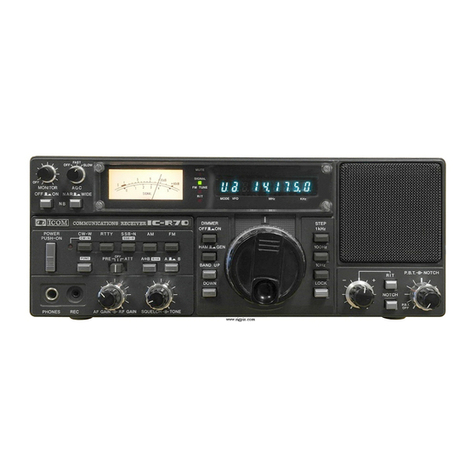
Icom
Icom IC-R70 User manual
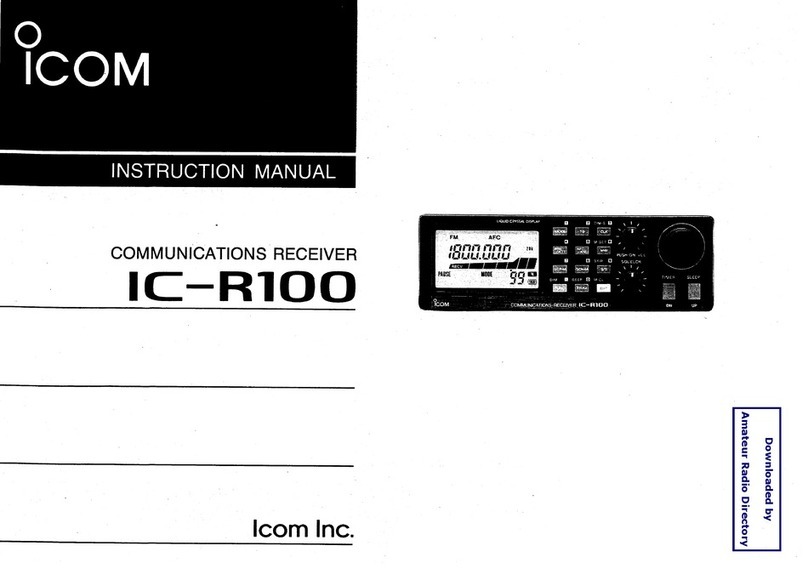
Icom
Icom IC-R100 User manual
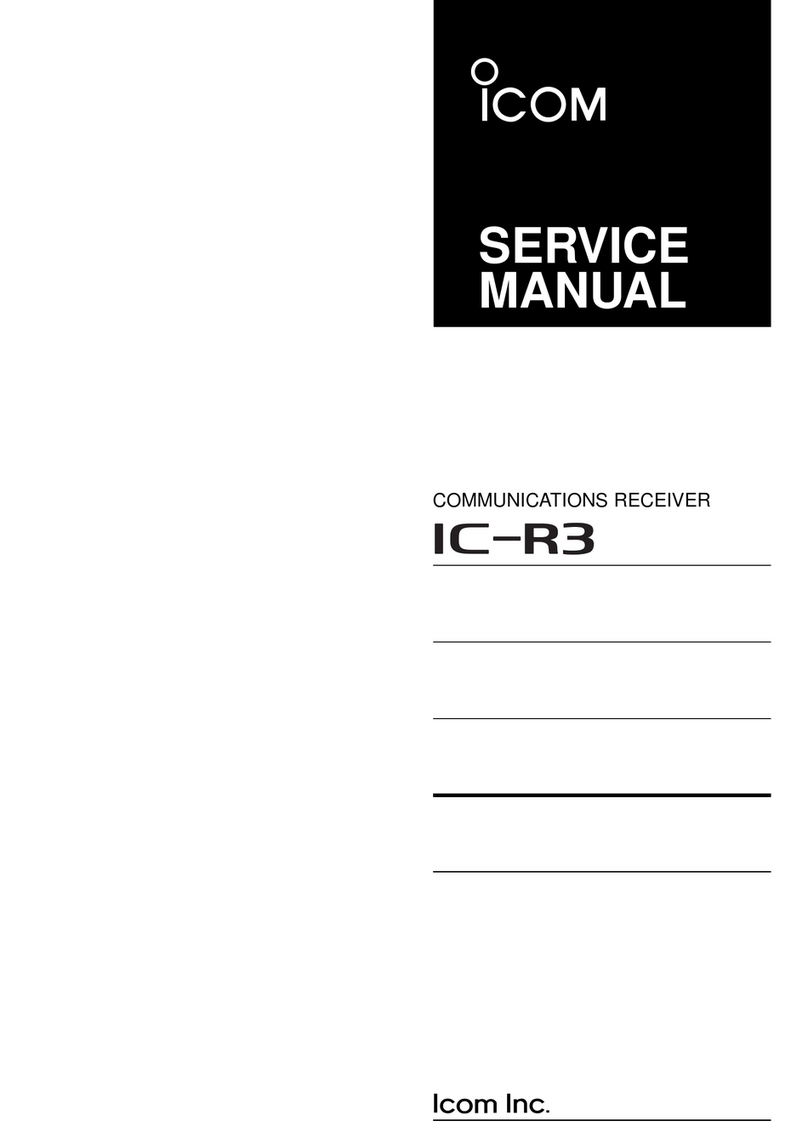
Icom
Icom COMMUNICATIONS RECEIVER IC-R3 User manual
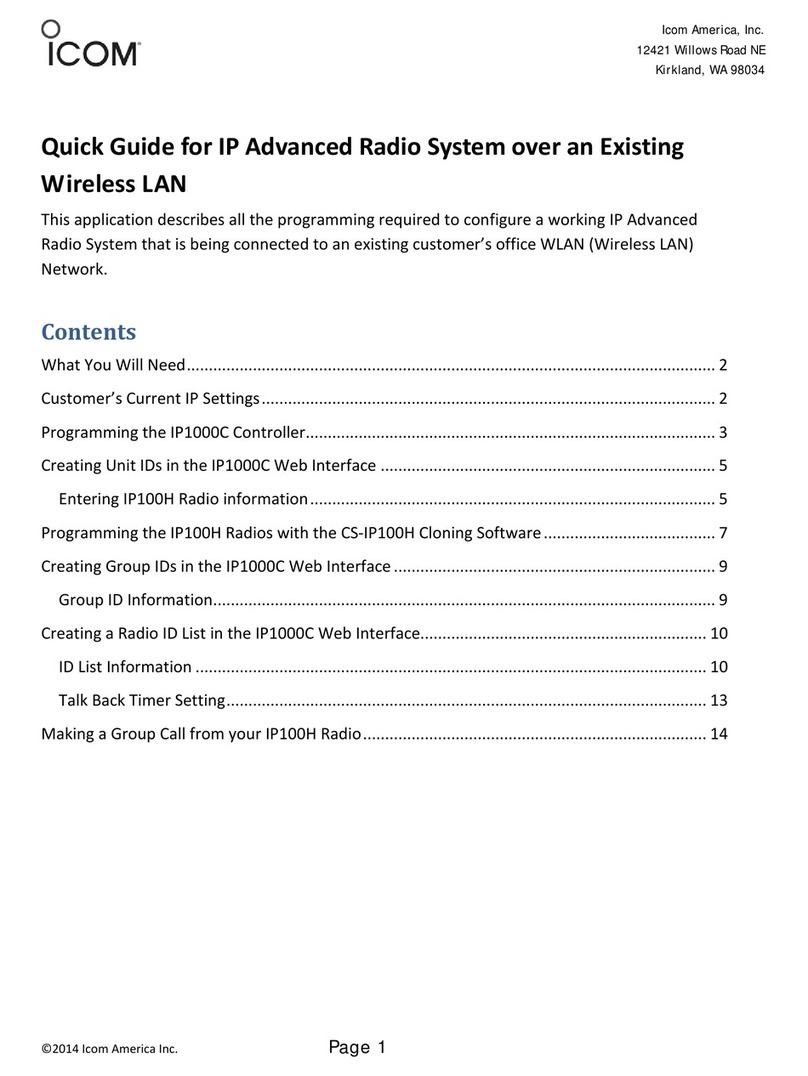
Icom
Icom IP100H User manual
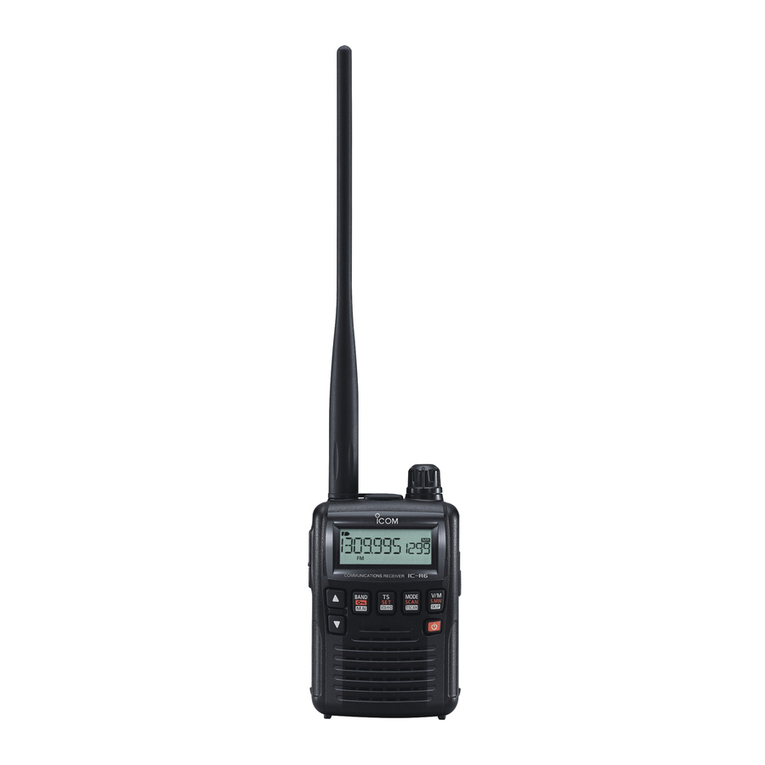
Icom
Icom IC-R6 User manual
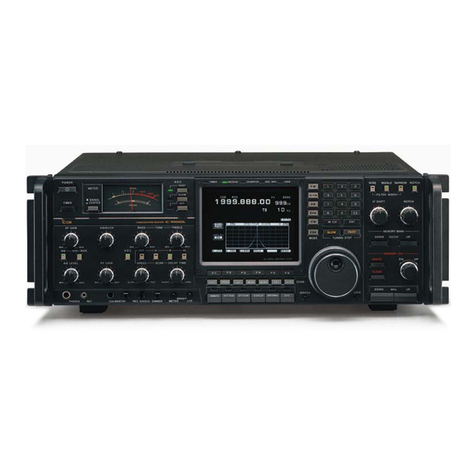
Icom
Icom IC-R9000L User manual
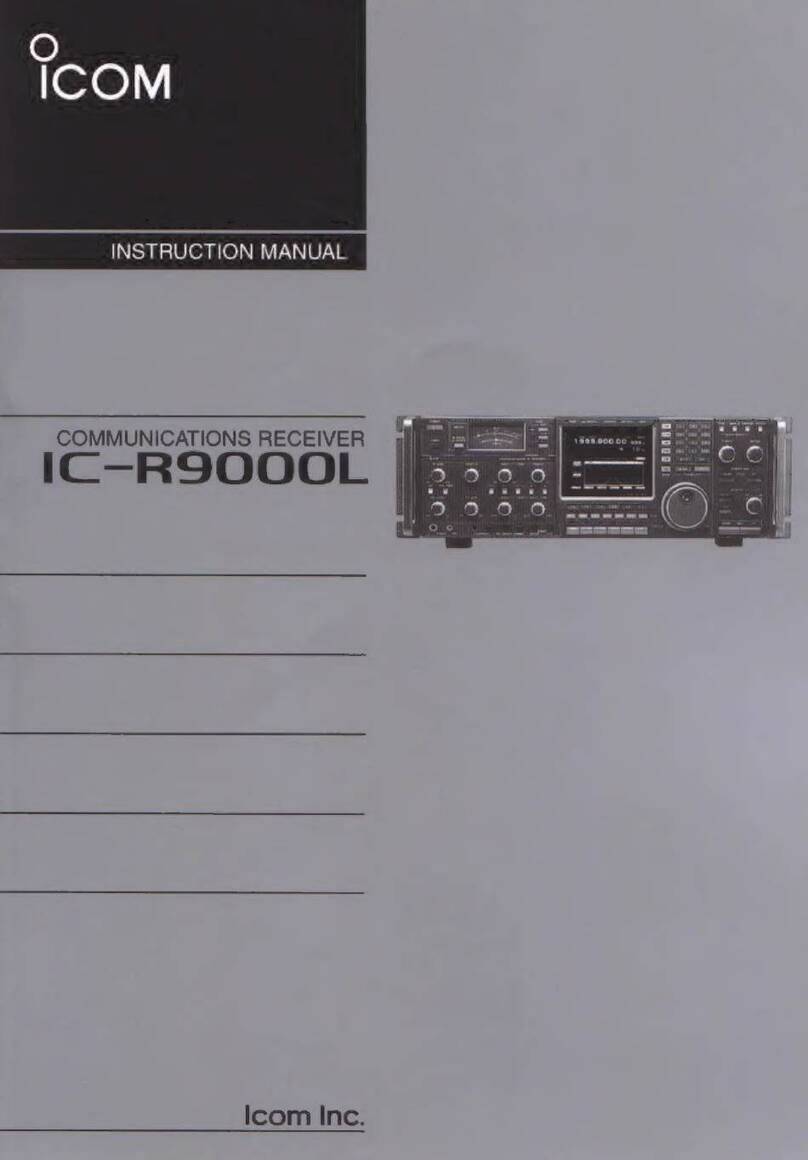
Icom
Icom IC-RSOOCOL User manual
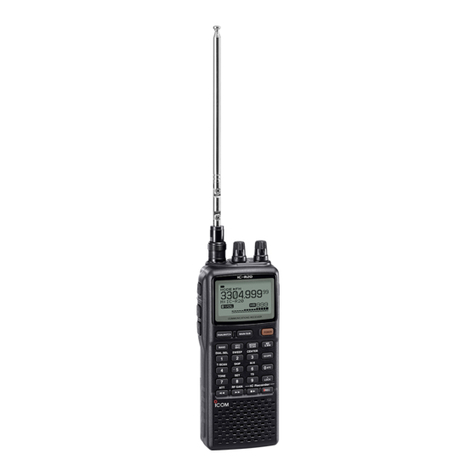
Icom
Icom IC-R20 User manual
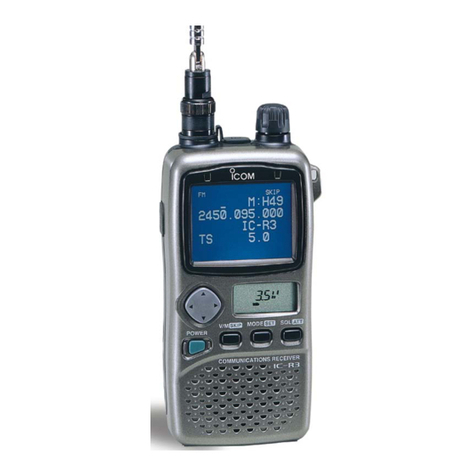
Icom
Icom COMMUNICATIONS RECEIVER IC-R3 User manual

Icom
Icom FP-561 User manual
